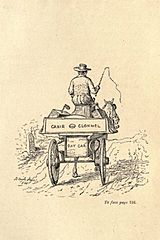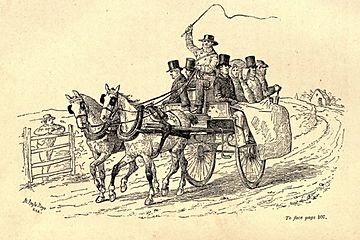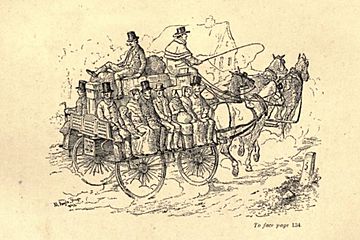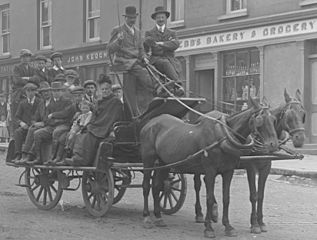Charles Bianconi facts for kids
Quick facts for kids
Charles Bianconi
|
|
|---|---|
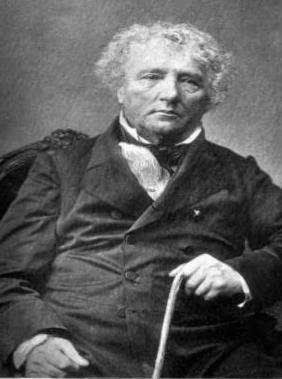 |
|
| Born | 24 September 1786 Tregolo, Costa Masnaga (near Como), Italy
|
| Died | 22 September 1875 (aged 88) Longfield House, Boherlahan, County Tipperary, Ireland
|
| Spouse(s) | Eliza Hayes |
Charles Bianconi (born September 24, 1786 – died September 22, 1875) was a clever businessman from Italy who later lived in Ireland. People sometimes called him the "man who put Ireland on wheels." This is because he created a huge network of horse-drawn coaches. These coaches became Ireland's first regular public transport system. He was known for his new ideas in travel and even served as the mayor of Clonmel, in County Tipperary, twice.
Contents
Early Life of Charles Bianconi
Charles Bianconi was born Carlo Bianconi in Costa Masnaga, Italy, on September 24, 1786. When he was 16, in 1802, he moved to Ireland. He traveled through England to get there. At that time, people in Britain were worried about attacks from other countries. This meant it was harder for foreigners to enter. When he arrived in Ireland, he changed his name from Carlo to Charles.
Charles Bianconi's Career in Transport

When Charles was 16, he worked in Dublin as an engraver and printseller. He learned from his sponsor, Andrea Faroni. In 1806, he opened his own shop in Carrick-on-Suir. He moved his business to Clonmel in 1815.
Many people see Charles Bianconi as the person who started public transportation in Ireland. He built on ideas from an earlier system of mail coaches. These coaches and roads were set up by John Anderson before 1790. After Anderson's business failed in 1815, Bianconi started his own regular horse-drawn carriage services. This began around 1815.
He said two main things helped him succeed:
- First, there was a tax on private carriages. This meant many middle-class families could not afford their own vehicles.
- Second, after a big war (the Battle of Waterloo), there were many strong horses available. These horses were no longer needed for the army, so they were cheap to buy.
Bianconi realized that a type of family carriage, called a jaunting-car, was perfect for his plan. He could buy these vehicles very cheaply.
His first coach service went from Clonmel to Cahir. This journey used to take five to eight hours by boat. With Bianconi’s carriage, it took only two hours! Traveling on one of his coaches, often called a ‘Bian’, cost about one penny farthing per mile. His open 'Bianconi coaches' were very popular for over a hundred years.
There were also special places to stay called Bianconi Inns. Some of these inns still exist today. You can find them in Piltown, County Kilkenny, and Killorglin, County Kerry. His coach services continued even into the 1850s. By then, there were also many railway services in Ireland. Bianconi's coaches remained popular because they connected to the train stations. This was one of the first examples of an integrated transport system in Ireland. By 1865, Bianconi was earning about £35,000 each year.
Later Life and Death
Charles Bianconi passed away on September 22, 1875. He died at Longfield House, in Boherlahan, County Tipperary.
He had given land to the church in Boherlahan to help build a new church. He wanted to be buried there. He and his family are buried in a small chapel next to the parish church in Boherlahan. This is about 5 miles from Cashel, County Tipperary.
Family Life
In 1832, Charles Bianconi married Eliza Hayes. She was the daughter of a rich stockbroker from Dublin. They had three children: Charles Thomas Bianconi, Catherine Henrietta Bianconi, and Mary Anne Bianconi. Mary Anne later married Morgan John O'Connell. She also wrote a book about her father in 1878. This book included stories from artists and writers who knew him well.


